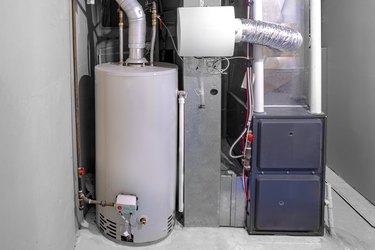
Homes with a gas- or oil-fired boiler to supply hot water for a hydronic heating system are typically divided into heating zones, and circulation to each zone is controlled by a zone valve. The actual valve is installed into the water line at the manifold, which is where the main water line branches into separate zones. The removable head, which operates a piston that controls the valve, snaps onto it. A number of manufacturers make these valves, and one of the most popular is Taco.
The Taco zone valve has three electrical connections, and one of them goes to the main boiler controls. If the boiler isn't firing up, the zone valve may be the culprit. It's fairly easy to test the valve with a multimeter, and if the test reveals an internal electrical problem, you can replace the head without disturbing the valve itself. That makes this job one that can be accomplished by any DIY-minded homeowner.
Video of the Day
Video of the Day
How a Taco Zone Valve Works
A Taco zone valve has three wiring terminals arranged in a vertical column on the head. The top terminal receives 24-volt power from the system transformer — via the thermostat — and the middle one is a common terminal that serves as a return path to complete the circuit to the transformer. When the thermostat calls for heat, the circuit closes and the electric current heats up an element in the valve head, which allows the valve to open.
The third terminal is a stop switch. It's connected internally to the common terminal and wired externally to the circulation pump. When the heat generated by the current flowing in from the transformer causes the internal switch to close, power flows to the pump and it switches on. There's a 90-second lag between when the first terminal gets power and when the bottom terminal sends power to the circulating pump. This is to ensure the pump doesn't switch on while the valve is closed.
Testing the Top Terminals for Voltage
The first test you can perform with a multimeter to diagnose a possibly defective zone valve is a voltage test. Set a digital multimeter to measure AC volts and connect the leads to the top and middle terminals with alligator clips. Set the thermostat to a high temperature so it will call for heat and close the circuit, and when it does, the meter should read 24 volts or above — the reading is often in the range of 26 volts.
If you don't get a voltage reading, there could be an internal wiring problem in the valve head, but it's also possible the thermostat isn't closing, so you also have to test it. You should also test the transformer to make sure it's actually sending 24-volt power to the thermostat before you blame the zone valve. If both of these system components check out, it's time to replace the valve head. You do this by rotating the head to make it pop off and installing a new head by reversing that procedure.
Testing the Bottom Terminals for Continuity
If the switch between the bottom terminal and the middle common terminal doesn't close, the valve won't send power to the circulation pump and it won't start. To determine whether this switch is closing, you need to set the multimeter to measure ohms (Ω) of resistance and do a continuity test. For this test, you can leave one lead connected to the middle terminal and change the other lead from the top to the bottom terminal.
When the thermostat is off, the resistance should be very high; most digital multimeters display OL to signify this — it means Open Line. After the thermostat closes, wait for at least 90 seconds and check the meter again. You should see a very low resistance, which means the switch has closed. If the meter reading never changes from OL, the switch isn't closing and you need to replace the valve head.